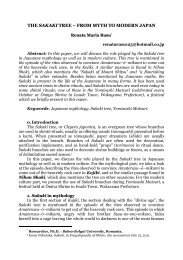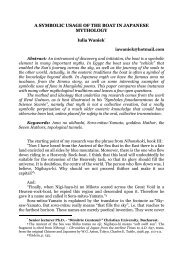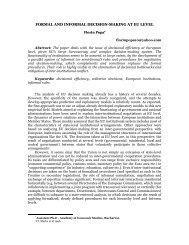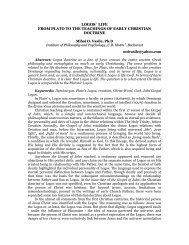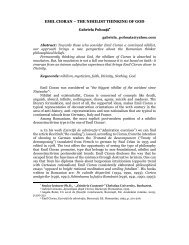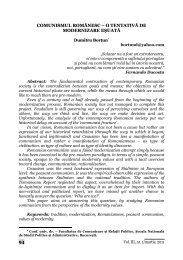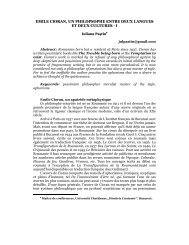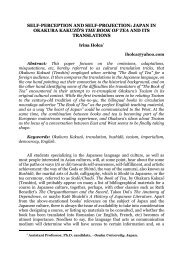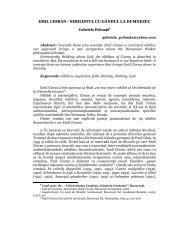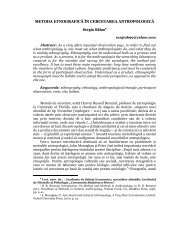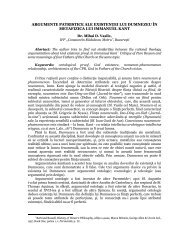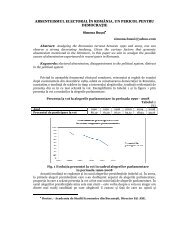JAPANESE TRADITIONAL RAIMENT IN THE CONTEXT OF ... - cogito
JAPANESE TRADITIONAL RAIMENT IN THE CONTEXT OF ... - cogito
JAPANESE TRADITIONAL RAIMENT IN THE CONTEXT OF ... - cogito
You also want an ePaper? Increase the reach of your titles
YUMPU automatically turns print PDFs into web optimized ePapers that Google loves.
animals do so simply by hiding into their winter dens. It is the spiritual exploits<br />
that differ human beings from animals. They enrich your heart, and, thus, the<br />
society. If there is an idea of a 'way' to everything, even everyday activities, then<br />
there will be eternal peace and a way for development for a country.<br />
To sum up the thoughts on sodo's role in the life of the Japanese, Higuchi<br />
Kiyoyuki determines its social, cultural and humanistic meanings. He writes: "If<br />
one is wearing a kimono, which destroys the balance within society, the society<br />
perceives the person as a lunatic. Dressing up in the same clothes, as the Chinese<br />
do, is also no appropriate for us. The idea of a 'way' cannot exist without<br />
education. The notion ‘sodo’ suggests a way for self-improvement as well as the<br />
melioration of the society we live in.<br />
Thus, at the turn of XX – XXI c.c., the Japanese raiment seemed to<br />
transcend to a spiritual dimension, functioning not only as a means of national<br />
and cultural identity, but also as a way of moral and ethical upbringing. By<br />
changing oneself by way of putting on a kimono, one helps promote the spiritual<br />
in the country, and, hence, in the world 2 4 .<br />
Summing up, it ought to be emphasized, that the evolution of the Japanese<br />
raiment unfailingly reflects the changes in historical-and-cultural paradigms. The<br />
classical period, prior to the Meiji reforms, was thus marked with the Chinese and<br />
Korean influence on philosophy of the costume as a multilayer robe set rejecting<br />
the natural bodily and elevating one’s social status.<br />
The establishment of the Japanese raiment coincided in time with the sprawl<br />
of Zen-Buddhism and Confucianism. The Zen practices, which regimented the<br />
aesthetics of the interior and the ethic code of conduct, could not fail to influence<br />
the emergence of a new type of clothing, namely that enwrapping the body.<br />
The enhancement of the textile techniques and the special significance of the<br />
costume in the society’s perception enabled the projection of the centuries-old<br />
artistic experience onto the raiment decor.<br />
Paradoxically, the rapid modernization of Japan, which seemingly prompted<br />
the rejection of the national costume as synonymous to backwardness, not only<br />
accounted for its later comeback, but also for its 'revamp', both aesthetically and<br />
ethically. On the turn of the XXI century, the Japanese traditional raiment has<br />
come to serve not only as festive clothing, but also as an idiom of cultural<br />
identification and spiritual self-improvement.<br />
REFERENCES<br />
1. Ando, Hiroko. Japanese shibori. Kyoto, 1993<br />
安 藤 宏 子 「 日 本 の 絞 り」 京 都 一 九 九 三 年 九 六 頁 。<br />
2. Blakemore, F., (1978), Japanese Design Through Textile Patterns. New<br />
York & Tokyo.<br />
3. Dalby, L., (1993), Kimono: Fashioning Culture. Seattle.<br />
4. Dalby, L., (2008), Geisha. University of California Press.<br />
5. Fujisawa Noryo, E. Sano, Y.Woodson, Kawakami Shigeki, (1997), Four<br />
24<br />
Norio Yamanaka 2002, op.cit.




